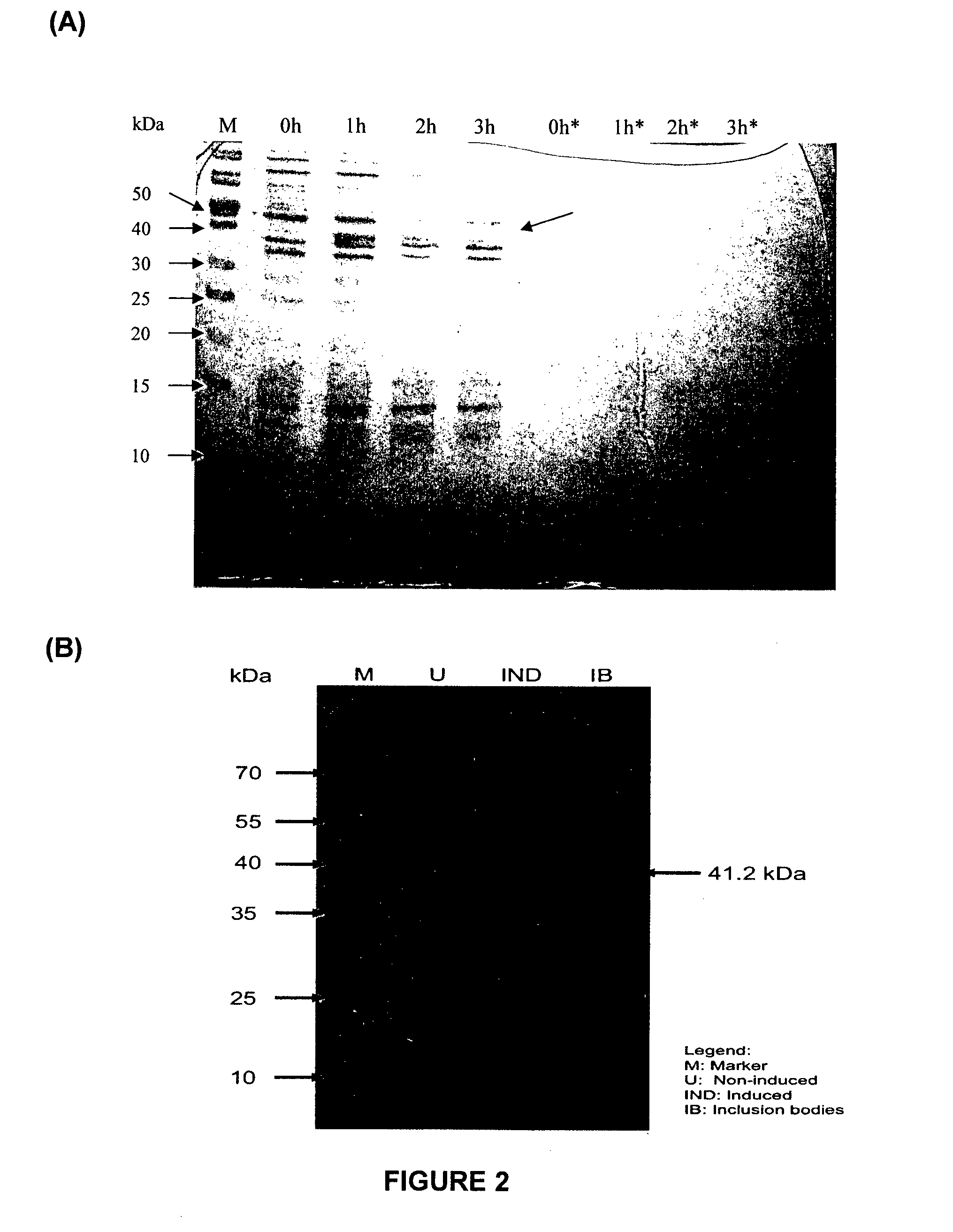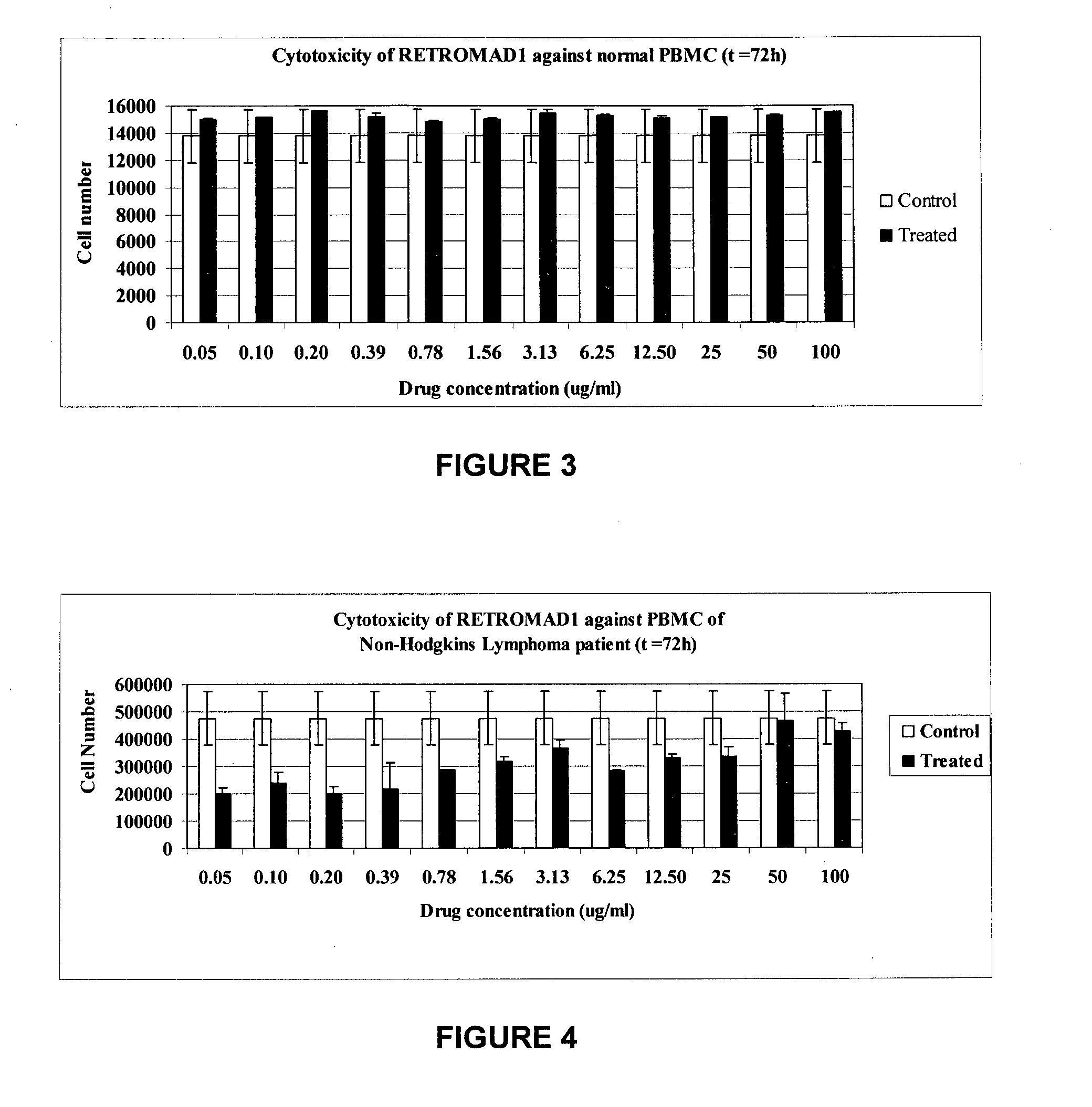Anticancer treatment
a technology of cancer treatment and fusion compounds, applied in the field of anticancer treatment, can solve the problems of only partially effective and non-specific treatment methods, and achieve the effect of optimal effectiveness
- Summary
- Abstract
- Description
- Claims
- Application Information
AI Technical Summary
Benefits of technology
Problems solved by technology
Method used
Image
Examples
example 1
Construction and Design of Expression Vector
[0151]The gene encoding RetroMAD1 A-B-C with SEQ ID NO:1 was synthesized and cloned into backbone of vector pGA4 at the KpnI / SacI site by contract service (GeneArt AG, Germany). The expected product size was 1140 bp, which encoded a 379 amino acid and an expected size of 41.2 kDa. The polynucleotide sequence and the translated polypeptide sequence are shown in FIG. 1 from PCT. The gene was sub-cloned into a pET expression vector (Novagen), pET-26(b) at the NcoI / HindIII sites. Kanamycin was used as a marker for selection and maintenance of culture purposes. This vector was inducible under the addition of isopropyl-beta-D-thiogalactopyranoside (IPTG). The plasmid, pRMD1 was then transformed into BL21(DE23) cells (Novagen) and plated on a selective media with Kanamycin.
Expression of RetroMAD1 from E. coli
[0152]One recombinant clone was grown in 10 ml of LB Bertani (DIFCO) medium, supplemented with 30 μg / ml kanamycin, at 37° C. overnight. Thi...
example 2
Preparation of Peripheral Blood Mononuclear Cells (PBMCs)
[0156]PBMC were isolated and blood samples collected into a 10 ml ethylenediaminetetraacetic acid (EDTA)-coated tube by density gradient centrifugation method. It was diluted at the ratio of 1:3 with RPMI-1640 (HyClone), layered onto Lymphoprep (Axis-Shield) and centrifuged at 2000 rpm for 30 minutes. During centrifugation, the PBMCs moved from the plasma and were suspended in density gradient. The PBMCs was washed twice with RPMI-1640 and subsequently were with RPMI-1640 medium. Cell viability was determined by tryphan blue exclusion method. The PBMC cell density used in this study was 1×106 cells / well of the 96-well tissue culture plate. PBMC of Non-Hodgkins' Lymphoma patient was incubated with twelve different concentrations of RetroMAD1 for a period of 72 hours. Cell viability was found to decrease as the range of drug concentration increases from 0.05 μg / ml to 3.13 μg / ml. Cells are found to be most viable at the drug conc...
example 3
Teratogenicity Studies
[0159]Thirty, Day 1 pregnant Sprague Dawley (SD) adult female rats were randomly divided into 3 groups and each group fed orally with (a) sterile distilled water (Control) (1 ml / kg bodyweight, 0.2 ml / 200 g rat); (b) 5 mg / kg of RetroMAD1 prepared in normal saline (low dose) and (c) 10 mg / kg of RetroMAD1 prepared in normal saline (high dose). The above mentioned regime was carried out for the adult female rats from day 1 pregnancy to day 20 and continued for 21 days post-delivery.
[0160]There are no signs of maternal toxicity or embryogenicity at 10 mg drug / kg body weight of pregnant rats treated from day 1 to day 20. There are no external fetal abnormalities, no growth delay, and no fetal death. The dam's (mother) weight gain after dosing, low and high dose of drug (gestational days 1 to 20) were comparable to normal control group. None of the pregnant rats delivered prematurely. The duration of gestation was unaffected by RetroMAD1.
[0161]There was no difference ...
PUM
| Property | Measurement | Unit |
|---|---|---|
| Current | aaaaa | aaaaa |
| Current | aaaaa | aaaaa |
| Current | aaaaa | aaaaa |
Abstract
Description
Claims
Application Information
 Login to View More
Login to View More - R&D
- Intellectual Property
- Life Sciences
- Materials
- Tech Scout
- Unparalleled Data Quality
- Higher Quality Content
- 60% Fewer Hallucinations
Browse by: Latest US Patents, China's latest patents, Technical Efficacy Thesaurus, Application Domain, Technology Topic, Popular Technical Reports.
© 2025 PatSnap. All rights reserved.Legal|Privacy policy|Modern Slavery Act Transparency Statement|Sitemap|About US| Contact US: help@patsnap.com



